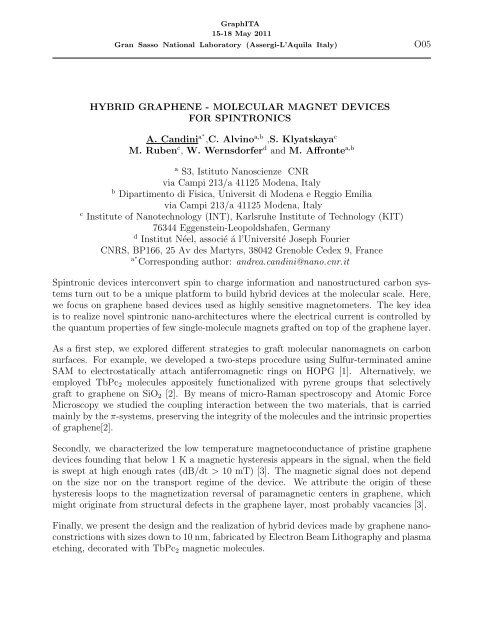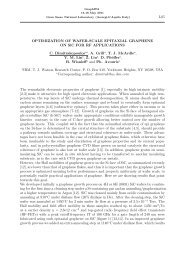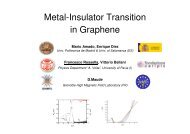Hybrid Graphene - Molecular Magnet Devices for ... - GraphITA - Cnr
Hybrid Graphene - Molecular Magnet Devices for ... - GraphITA - Cnr
Hybrid Graphene - Molecular Magnet Devices for ... - GraphITA - Cnr
You also want an ePaper? Increase the reach of your titles
YUMPU automatically turns print PDFs into web optimized ePapers that Google loves.
<strong>GraphITA</strong>15-18 May 2011Gran Sasso National Laboratory (Assergi-L’Aquila Italy)O05HYBRID GRAPHENE - MOLECULAR MAGNET DEVICESFOR SPINTRONICSA. Candini a∗ ,C. Alvino a,b ,S. Klyatskaya cM. Ruben c , W. Wernsdorfer d and M. Affronte a,ba S3, Istituto Nanoscienze CNRvia Campi 213/a 41125 Modena, Italyb Dipartimento di Fisica, Universit di Modena e Reggio Emiliavia Campi 213/a 41125 Modena, Italyc Institute of Nanotechnology (INT), Karlsruhe Institute of Technology (KIT)76344 Eggenstein-Leopoldshafen, Germanyd Institut Néel, associé á l’Université Joseph FourierCNRS, BP166, 25 Av des Martyrs, 38042 Grenoble Cedex 9, Francea ∗ Corresponding author: andrea.candini@nano.cnr.itSpintronic devices interconvert spin to charge in<strong>for</strong>mation and nanostructured carbon systemsturn out to be a unique plat<strong>for</strong>m to build hybrid devices at the molecular scale. Here,we focus on graphene based devices used as highly sensitive magnetometers. The key ideais to realize novel spintronic nano-architectures where the electrical current is controlled bythe quantum properties of few single-molecule magnets grafted on top of the graphene layer.As a first step, we explored different strategies to graft molecular nanomagnets on carbonsurfaces. For example, we developed a two-steps procedure using Sulfur-terminated amineSAM to electrostatically attach antiferromagnetic rings on HOPG [1]. Alternatively, weemployed TbPc 2 molecules appositely functionalized with pyrene groups that selectivelygraft to graphene on SiO 2 [2]. By means of micro-Raman spectroscopy and Atomic ForceMicroscopy we studied the coupling interaction between the two materials, that is carriedmainly by the π-systems, preserving the integrity of the molecules and the intrinsic propertiesof graphene[2].Secondly, we characterized the low temperature magnetoconductance of pristine graphenedevices founding that below 1 K a magnetic hysteresis appears in the signal, when the fieldis swept at high enough rates (dB/dt > 10 mT) [3]. The magnetic signal does not dependon the size nor on the transport regime of the device. We attribute the origin of thesehysteresis loops to the magnetization reversal of paramagnetic centers in graphene, whichmight originate from structural defects in the graphene layer, most probably vacancies [3].Finally, we present the design and the realization of hybrid devices made by graphene nanoconstrictionswith sizes down to 10 nm, fabricated by Electron Beam Lithography and plasmaetching, decorated with TbPc 2 magnetic molecules.
<strong>GraphITA</strong>15-18 May 2011Gran Sasso National Laboratory (Assergi-L’Aquila Italy)The magnetization reversal of the molecules in proximity with graphene is detected by themagnetoconductivity of these hybrid devices, which shows the uniaxial magnetic anisotropytypical of the TbPc 2 SMMs. Our results depict the behaviour of multiple-field-effect nanotransistorswith sensitivity at the single-molecule level [4][5].References[1] A. Ghirri et al. Advanced Functional Materials 20, (2010), 1552-1560.[2] M. Lopes, A. Candini et al. ACS Nano 4, (2010), 7531-7537.[3] A. Candini, C. Alvino, W. Wernsdorfer and M. Affronte. In press in Physical ReviewB Rapid Communication (2011) (selected as an Editor’s Suggestion). Available online at:arXiv:1101.3030v1.[4] A. Candini, S. Klyatskaya, M. Ruben, W.Wernsdorfer, M. Affronte. submitted (2011).[5] This work has been supported by FP7-ICT FET Open ’MolSpinQIP’ project funded byEU, contract N. 211284, the ERC advanced grant MolNanoSpin (N. 226558), the priorityprogram 1149 ’<strong>Graphene</strong>’ by the German Science Foundation (DFG), and the ANR-Pnanoproject MolNanoSpin.






